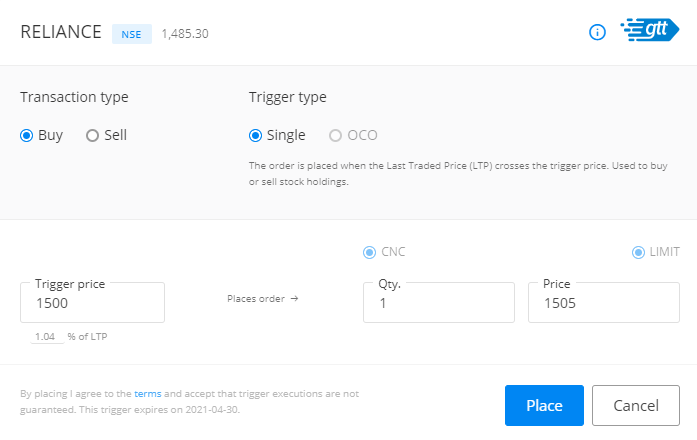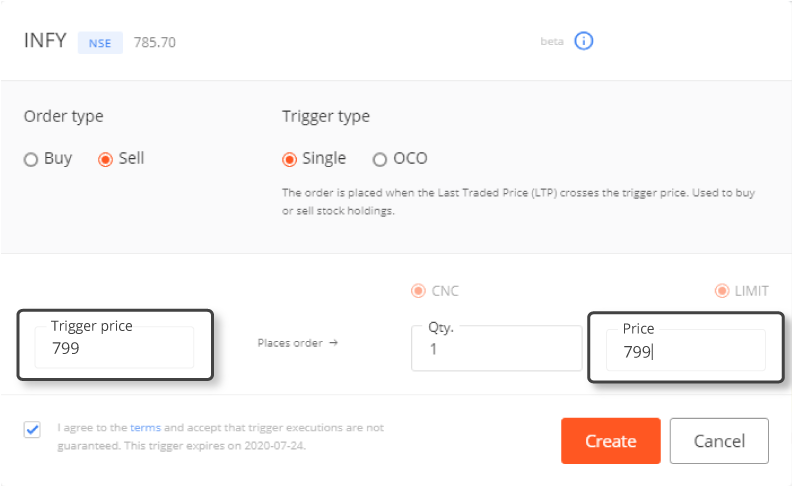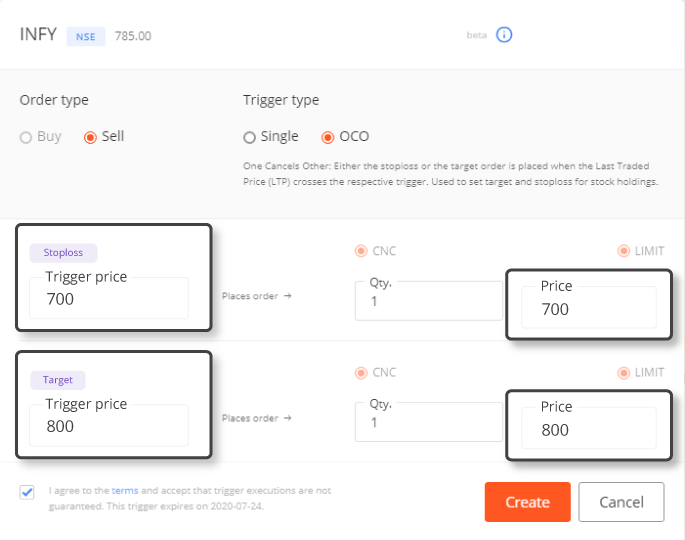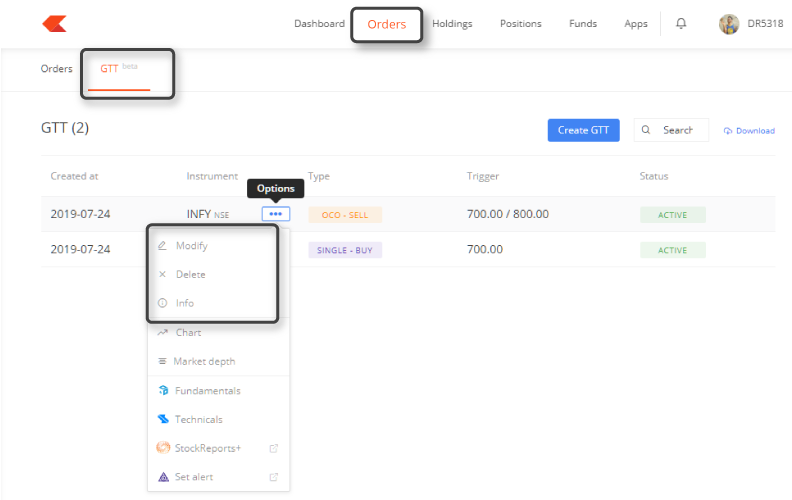GTT is a feature which lets you set a trigger value, such that; in case your trigger value is hit in a future date, a limit order will probably be positioned on the exchange as per the limit value and preset conditions set by you.
GTT can be used just for CNC type orders within the Equity Cash segment on NSE & BSE and NRML type orders within the Equity Derivatives segment on NSE.
A GTT is a trigger which places a limit order (on the limit value chosen by you) as and when the trigger value, chosen by you, is met or breached. In case the trigger value is breached during a selected day and the limit value chosen isn’t precisely met on the identical day, all such orders will probably be cancelled on the finish of such trading day session.
The trigger set on GTT is legitimate only once, if the order is placed and isn’t executed for any motive, the GTT order needs to be changed once more.
If the Last Traded Price (LTP) of a scrip jumps larger than the set off value chosen, or if the LTP opens at a spot up or hole down breaching the chosen set off value, an order can be positioned on the chosen limit value.
GTC orders
GTC (Good Till Cancelled) orders are orders which can be valid till cancelled. They’re mostly used for putting long run stop loss and target orders. Providing this has been a problem as a result of exchanges in India don’t help this characteristic; all pending orders are cancelled by the change on the finish of each buying and selling day. The few brokers who do provide GTC, essentially replace all the pending orders which were cancelled by exchange once again on the subsequent buying and selling day. This is not a scalable solution.
We’ve developed an innovative alternative to GTC that gives all of its options and extra. Not solely are you able to place single-leg triggers to enter or exit stock holdings till your value situation is met, however you may as well concurrently place target and stoploss (OCO or One Cancels Other) to your stock holdings.
Creating GTTs
On Kite web, click on on the context menu (marketwatch, holdings, positions) to see the Create GTT option.
Making a GTT on Kite web
On Kite mobile, click on on any scrip and click on on ‘Create GTT’ on the right.
Types of GTT
Buy GTT
Buy GTT can be used to creating triggers to purchase shares for delivery. When the trigger value is hit, a purchase order with the entered limit value is positioned on the exchange.
Consider the example within the picture beneath:
Present value of Reliance = 1485.30
Trigger value = 1500
Limit value = 1505
In this example, if the trigger value of 1500 is hit on the exchange, a limit purchase order at 1505 is positioned. Because the limit value is bigger than the market value, the order behaves like a market order and executes at 1500. However, since this can be a limit order, it won’t be filled at a value above 1505. The reason for having a limit value larger than the trigger value is to make sure that the order is executed when triggered and doesn’t keep pending and get cancelled.
Purchase GTT — Single
Sell GTT
The Sell GTT is used to exit present stock holdings, both only a target order or both stoploss and target where triggering of 1 will cancel the other (OCO).
Sell GTT – Single:
Consider the example within the picture beneath:
Present value of Infy = 785.70
Trigger value = 799
Limit value = 799
In this example, if the trigger value of 799 is hit on the exchange, a limit sell order at 799 is positioned. This order will probably be executed when you’ve got the stock in your demat account and a buyer is available.
Sell GTT – Single
Sell GTT – OCO (One Cancels Other):
Consider the example within the picture beneath:
Present value of Infy = 785
Stoploss trigger value = 700
Stoploss limit value = 700
Target trigger value = 800
Target limit value = 800
In this example, if both trigger value of 700 or 800 is hit on the exchange, a limit sell order on the corresponding limit value is positioned. This order will probably be executed when you’ve got the stock in your demat account and a buyer is available. The opposite trigger is cancelled when one is hit.
Sell GTT – OCO
Using percentages to set triggers
You can also easily set your GTT triggers at any desired percentage factors away from the LTP. Consider the example within the picture beneath:
Present value of Infy = 793.65
Stoploss trigger value = 674.6 (-15% from LTP)
Target trigger value = 912.65 (15% from LTP)
You can merely change the proportion value beneath the ‘Trigger value’ field (constructive for target and negative for stoploss) and the trigger value will robotically be set to that level. You solely must enter the limit value.
Setting triggers 15% away from LTP
GTT for Nifty and Banknifty F&O
We’ve now extended the GTT feature from to include Nifty and Bank Nifty futures and options. You may as well set the target and stoposs as a % of the price at which your order will get traded whereas inserting the order itself. This feature is currently obtainable on Kite web and will probably be launched on the mobile app soon.
Within the picture beneath, whereas placing a buy Nifty May Futures market order, an SL and target of 1% are set. What this implies is that regardless of the value at which the market order will get executed, a sell GTT is positioned at 1% above and below that value. If both of these will get executed, the opposite will get cancelled.
Setting SL and Target whereas placing a Nifty futures market order
Managing your GTTs
All GTTs placed you place can be managed below the GTT tab on the Orders web page of Kite.
GTT Tracking
Margins
You don’t have to have any money or margins available in your account to create a GTT. The system solely checks for margins when the GTT is triggered and an order must be positioned on the change. You will want to have margin obtainable only then.
Validity
- A GTT is valid for one yr. If it isn’t triggered within one yr, the GTT will probably be cancelled. You will want to position the GTT once more manually if required.
- A GTT trigger is valid only as soon as. So, if an order fired by a GTT isn’t filled on the exchange for any motive, you have to to re-place the GTT order manually.
- Each time there’s a company motion, like bonus, dividend (if higher than 5% of market value), stock split, and so on., the GTTs for the corresponding shares will probably be cancelled before the ex-date. You’ll have to re-place the GTT manually after the company action. These GTTs are cancelled to make sure that the order isn’t triggered by the motion of stock value because of the company motion.
Important to know
- When a GTT is triggered, and order is positioned on the exchange, it’s executed provided that the limit value order positioned is filled on the exchange. To be assured of execution, make sure that to position your limit value larger than the trigger value for buy GTT orders (acts like a market order with the safety of your limit set), and promote limit value lower than the sell trigger price for sell GTT orders. The further away from the trigger, extra more likely to be assured execution.
- All orders will probably be triggered and positioned solely throughout market hours.
- Orders positioned on the exchange by GTTs that trigger will only be filled when you’ve got sufficient funds for buys and when you’ve got sufficient stock in your demat for sells when the order is positioned on the exchange.
- Our dealing desk doesn’t help GTT; you’ll have to place, cancel, modify these by yourself.
- A most of 50 active GTTs is may be positioned at a time on one account.
- If you’re inserting a sell GTT in your equity holdings, make sure that to authorise the supply of your shares using CDSL TPIN. The validity of authorisation is simply 90 days. This isn’t required if you happen to’ve submitted a POA.
Free to be used
There aren’t any additional prices for utilizing the GTT feature.
Assist us spread the phrase by letting all your mates learn about GTT. It may assist save time by not having to login day by day to position orders and assist save money by having a stoploss in place when an funding doesn’t go within the anticipated route.






